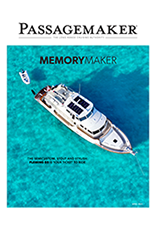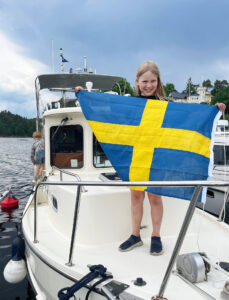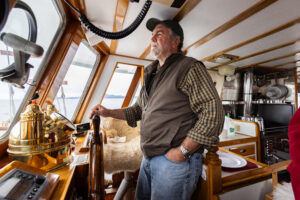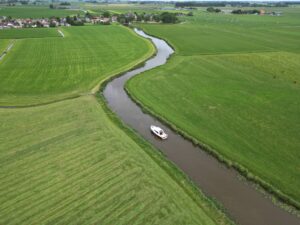On October 18, 1805, Lieutenant William Clark wrote in his journal that he had sighted spectacular Mt. Hood while traveling down the Columbia River with his fellow explorer, Captain Meriwether Lewis. Retracing parts of the famous Lewis & Clark Expedition more than 200 years later, Tony Fleming and his crew were similarly awestruck by the raw beauty of snow-capped Mt. Hood and the surrounding Columbia River Gorge. Fleming’s 65-foot Venture was underway on a 360-mile exploration of the Pacific Northwest’s Columbia and Snake Rivers from Portland, Oregon, to Lewiston, Idaho.

While a number of small cruise lines follow this legendary route, promoting its majestic scenery and historical significance, Fleming found few private cruising boats venturing past Hood River, the picturesque, wind-blown town located 65 miles east of Portland. Even fewer boats cruised beyond The Dalles, a small town situated 20 miles farther east. Known for his adventurous, offshore voyages, Fleming would soon discover a different set of challenges that would make this river cruise no less exciting.
Indeed, with the exception of one atlas of river charts and only rudimentary info about locks and marinas, there were no cruising guides to help Fleming’s captain, Chris Conklin, plan the voyage. But Fleming—the retired boatbuilder and accomplished documentary filmmaker—was intrigued by the geological history of the area. He not only wanted to capture the sheer beauty of the area but also to witness the signs of how it was created 15,000 years ago by gigantic floods and massive landslides.
JUMP-OFF POINT

The Columbia River Gorge, a National Scenic Area totalling nearly 300,000 acres, measures 80 miles long and cuts a river canyon 4,000 feet deep. It begins 15 miles east of Portland, Oregon, at the mouth of the Sandy River, a tributary of the Columbia. Arriving in Portland in time for its month-long Rose Festival, Conklin found space along the city docks, giving Venture front-row seats to many of the downtown festivities.

Taking advantage of easy-to-access public transportation, the crew also enjoyed a number of attractions throughout the city, including its beautiful Rose Garden, serene Japanese Garden, and popular Saturday Farmers Market. With a population of over 600,000 and situated between the Columbia and Willamette Rivers, Portland has much to offer visiting boaters. Portland’s one shortcoming, however, is that the number of downtown marinas is extremely limited, and the one most conveniently located, River Place Marina, offers little, if any, transient space.
LOCAL WISDOM
Hoping to gain some local knowledge of his planned route, Fleming accepted an invitation of overnight dockage at the Columbia River Yacht Club on Hayden Island, just off the northern side of Portland. One of the few club members to have made the trip all the way to Lewiston briefed Venture’s crew on the route’s various challenges, but always adding a reassuring, “You’re going to have a great time.” Among the noted challenges were strong river currents, high winds, and the need for recreational vessels to follow strict schedules for transiting the eight locks between Portland and Lewiston.

Adding to these challenges, a number of the facilities and personnel along the way seemed indifferent, or at least unused to, serving larger cruising boats. To begin with, there were few marinas east of The Dalles that could easily accommodate Venture’s 70-foot overall length. Even those with deep enough water and available dock space were manned by part-time or hard-to-contact dock masters. Without exception, VHF calls from Venture went unanswered. In the case of Portland’s River Place Marina, Conklin left several messages to confirm his reservation made the week before, only to find upon arrival that all slips were full, the dock gate to the office locked, and the so-called manager nowhere to be found. At a marina farther east, Conklin was told to leave cash in a lock box along the dock, but the box had been vandalized, and the dockmaster would not return calls. And even when he was able to get people on the phone, he was often told, “Well, there might be room for you when you get here, but I can’t guarantee anything.” Venture was lucky enough, though, to get off the river each night and tie up to a secure dock. Since there was only a 50-50 chance of finding dockside power and water, it was fortunate that Venture is totally self-sufficient. It soon became obvious that this inland river route was a route less traveled.
SWIMMING UPSTREAM
Casting aside these challenges, Venture proceeded east, providing a steady platform for Fleming to shoot high-definition footage of the Columbia River Gorge’s magnificent scenery. He would eventually spend hours editing the footage, adding music, maps, and informative narrative to create another professional-quality documentary, similar to his recent films charting the crew’s voyage to the Aleutian Islands.

With the state of Washington on her port side and Oregon to starboard, Venture passed through 15 miles of some of the most scenic sections of the Gorge, from Crown Point (25 miles east of Portland) to Bonneville Dam and Lock. Unfortunately, a number of the area’s most iconic sights, including the spectacular Latourell Falls, Bridal Veil Falls, Multnomah Falls, and Horsetail Falls are not accessible from the river and are best seen by following the historic Columbia River Highway by car. With caution, however, Venture navigated the cut into Beacon Rock State Park, where it tied up along a 900-foot public dock. This historic 850-foot high rock is the core of an ancient volcano, and today features a mile-long switchback stairway trail to its summit, where one can get a dazzling view of the Gorge. It is here that Lewis & Clark determined that the tidal influence on the Columbia River ended.

Venture’s next stop was the Bonneville Dam with its 72-foot lift lock. Starting at 0900, the lock operates during daylight every three hours for recreational vessels, and locking through entails a simple, straightforward procedure. With a midships line looped around a floating bollard and both thrusters keeping the bow and stern off the lock wall, Venture was gently lifted skyward, reaching the higher river level in less than a half-hour. But even this 65-foot, 125,000-pound vessel seemed miniscule in this lock built specifically for barge traffic.
In the near distance a steel truss bridge appeared, connecting Washington to Oregon. This “Bridge of the Gods” was named after a massive landslide hundreds of years ago that created a natural bridge that measured 200 feet high. Eventually the Columbia River broke through, forming the Cascade Rapids which Lewis and Clark had to portage on their way west. In the late 1800s, the small town of nearby Cascade Locks was born after the U.S. government built a set of locks that provided safe navigation past the rapids. Finally, in the 1930s, the Bonneville Dam and Lock was built five miles to the west, submerging the rapids and rendering the Cascade Locks obsolete. Today, an attractive waterfront park follows the form of the old lock walls and includes a small marina, campground, restored lock-tender homes, a museum, a sternwheeler cruise ship, and a nearby brewery.

WINDSURFER’S PARADISE

Among the top attractions of the area is Mt. Hood, the snow-capped mountain just 50 miles from Portland. Although it is more than 11,000 feet high, it is only occasionally visible between gaps in the high cliffs forming the Gorge. As Venture continued east on her way to the town of Hood River on the Oregon side, the majestic mountain made a grand appearance, its peak partially hidden by fast-moving, low clouds. Although considered a “potentially active” volcano, the chances of eruption are relatively slim. After arriving in Hood River and finding dock space at the Port of Hood River Marina, Fleming and his crew borrowed a car from a local friend (renting a car here is difficult, if not impossible) and toured the area, exploring three main attractions: Hood River Valley’s Fruit Loop, Mt. Hood’s Timberline Lodge, and the Bonneville Dam.
The Fruit Loop spans 35 miles of wineries, U-pick farms, and farm stands. Many of the wineries offer tasting rooms, and after sampling a Wy’East (the Indian name for Mt. Hood) Pinot Noir, Venture’s wine locker was replenished with this locally produced gem. Despite lowland temperatures around 80 degrees in downtown Hood River, the ski slopes were open at Timberline Lodge, and remain open all year. Those who remember Stephen King’s movie, The Shining, will recognize the exterior, as aerials of it were used for establishing shots of the fictional Overlook Hotel.

High on the list of interesting attractions is the Bonneville Dam and Lock, where guided tours of its inner workings are given. Standing atop the 60,000kW turbine generators located below the river level is quite a sensation. Generating a total of 1,200 megawatts of power, Bonneville is joined by other dams along the Columbia and Snake Rivers that together provide 40% of the nation’s hydroelectricity.

A visit to Hood River is not complete without a walk along Waterfront Park to see the windsurfers and kiteboarders perform their heroic, athletic moves, pushed to the limits by prevailing 30-knot winds. Indeed, much of the local culture is centered on the sport, as evidenced by ‘round-the-clock webcams and online wind reports. And while there is no denying this is a young person’s sport, many older, even middle-age athletes, were spotted in midair, doing amazing aerials. Some came here 25-years ago for a windsurfing vacation and never left.
PAST THE DALLES

As Venture proceeded east, the landscape began to change to more desert-like terrain. The Dalles is a small town located 85 miles east of Portland. Dockage was found at Port of The Dalles Marina, one of the better facilities along the inland route. Dockage was only $10/night plus $20 for 50-amp service, and the floating docks and connecting ramps were like new. Adjacent to the very attractive Riverfront Park and its 10-mile-long walking trail, the marina was also within walking distance of the downtown area. Seemingly frozen in time with an antiquated JC Penney and Sears catalog stores, complete with sidewalk displays of washers and dryers, The Dalles projected an old-time friendliness with little pretension. Its local “yacht club” was no more than a small floating houseboat, and $5 could get you into an all-day beer festival.
SNAKE RIVER

Leaving The Dalles and heading to the Snake River turnoff 135 miles upriver, the Columbia River’s vertical cliffs, magical waterfalls, and green forests gave way to gracefully rolling, yellow-brown hills bare of vegetation. The Columbia River Gorge officially ends 10 miles east of The Dalles on a section of the river called Lake Celilo, followed by Lake Umatilla and Lake Wallula, all formed by the construction of dams on the Columbia River. As if following Venture, Mt. Hood continued to appear over the transom, majestically projecting its snow-capped peak above the horizon. Venture found just enough room for the night on the fuel dock of Umatilla Marina and RV Park, 100 miles east of The Dalles.
The scenery was changing, but the one constant was the wind. While the crew had been warned to watch conditions around Hood River where the opposing wind and river current can create 6-foot white caps, it also experienced 30-knot winds along the Snake River. Locking through Snake River’s Ice Harbor Lock, 10 miles beyond where the Snake meets the Columbia, was a challenge, as high winds actually created white caps inside the guillotine-gated lock. While Venture’s twin diesel engines and thrusters kept things under control, an underpowered, single-engine vessel would have had problems. From Ice Harbor Lock, Venture had 125 miles and three more locks to transit before reaching its final destination of Lewiston.

The old saying, “It’s about the journey, not the destination” could not have been more appropriate for Fleming and his crew as they continued along the Snake River. Its dramatic topographical features, the result of massive floods following the Ice Age, consist of wide, arid plains and rolling hills bordered by high mountains. Because its desert-like climate produces less than 12 inches per year of precipitation–a sharp contrast to the temperate rainforests of the Columbia River Gorge–the scenery is beautifully stark, especially when set against a deep blue sky and puffy white clouds. By early evening Venture reached Lyons Ferry Marina and RV Park, covering 112 miles and transiting two more locks after leaving Umatilla. Although the facility had seen better days, this was a rare case where not only was a dockmaster on duty, but he enthusiastically greeted Venture’s crew, even offering to keep his café and store open after hours.

Spectacular panoramas surrounded Venture as she continued east, transiting Little Goose Lock and stopping for the night at Boyer Park and Marina, 40 miles away and one lock shy of Lewiston. Like most marinas along the route, Boyer Park accommodated mostly small fishing skiffs, small-to-medium-size houseboats, and RVs. The narrow entrance was tricky for a boat of Venture’s size, as Conklin discovered when leaving the next morning. A loud crunch was heard throughout the boat as Venture’s protective keel hit the rocky bottom. A quick engine room check found no apparent damage, but the next scheduled haul out would provide a more definitive appraisal.
FINALLY TO LEWISTON
Venture reached the symbolic finish line by crossing the state boundary between Clarkston, Washington, and Lewiston, Idaho, 11 days and 360 miles after leaving Portland in the rearview mirror. Securing dockage across the river at the Port of Clarkston’s commercial Gateway Dock, Fleming began work on reviewing his video footage and writing his blog, much of which presents a detailed history and description of the territory explored by Lewis and Clark. While a lot has changed along these rivers due to the ambitious building of dams and locks that provide safe navigation as well as dependable hydroelectric power, much of its topographical history is permanently inked in its mountains, canyon walls, and waterfalls. It is a visual history well worth seeing.












